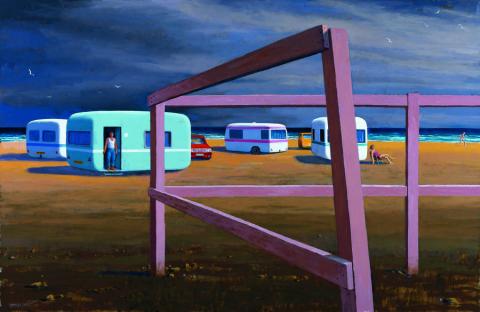THE CARAVAN PARK, 2007
JEFFREY SMART
oil on canvas
90.0 x 139.0 cm
signed lower left: JEFFREY SMART
Philip Bacon Galleries, Brisbane
Private collection, Brisbane
Jeffrey Smart, Philip Bacon Galleries, Brisbane, 2008, cat. 10 (illus. in exhibition catalogue)
Allen, C., Unpublished Paintings 1940–2007, Australian Galleries, Collingwood, 2008, p. 281 (illus.)
Strickland, K., 'Servings for a rich palate', Australian Financial Review Weekend, April 12 – 13, 2008, p. 43 (illus.)
As Jeffrey Smart built his long career, both in Australia and in Italy, he rang the changes through a range of subjects and themes that became fundamental to his work. Roads, bridges and airports, modernist buildings and open man-made landscapes gave scope for his clean, precise geometry and the opportunity to bring dramatic light effects under a dark and dramatic sky. But of all his subjects, it was the beach to which he returned for his most enigmatic compositions, at the meeting of land and sea. One of the first examples of his work to gain public notice, Holiday Resort, 1946, (Art Gallery of South Australia) carried with it the seeds of his view of the beach for the next sixty years. An abandoned pram on the hot, beaten earth, a solitary figure and a simple geometric pavilion denote a resort that is anything but inviting. That spare and slightly mysterious vision of the seaside carried through in a direct line over six decades to his Caravan Park, 2007. For Smart, the beach was no place for a jumbled mass of frolicking humanity, but a bare and empty stage on which small dramas and mysteries might be played out. They could be the mixed messages of Tamarama, 1954 (Private collection) or the surreal distortions of Quinces by the Sea, 1989 - 2003 (Private collection) but invariably Smart's seaside was a place of intrigue and wonder.
Caravan Park contains all the elements of Smart's best work in a composition, of classical geometry and romantic mystery. It is a carefully designed arrangement, which brings forth a curious story. Four caravans form a square on a flat field by the sea. They all appear to be the same design and colour, but only one is shown as having wheels, or indeed any of the mechanical paraphernalia that accompanies such a park. Three vans hover just above the grass, strange, almost alien cubicles from a faraway place. The composition is broken into vignettes by a stark pink fence, its colour and form a clear contrast to sea, land and sky. The post and rails break up the overall image into a number of smaller, quite self-contained compositions, each separate and seemingly unrelated. To the left, a young man stands at the door of his van, gazing toward the viewer, while the central vignette is devoid of life. Two cars provide a sharp colour contrast and the hint that the vans are occupied. To the right a woman relaxes in her deckchair, staring toward the lowering sun, while in the far right panel a figure runs across the sand, striding out of the frame. Each is oblivious to the others, engrossed in their own small holiday world.
Smart's fascination with the fundamental elements of painting never waned, even as he approached the end of his long and distinguished career. Caravan Park contains the best of his work - the fine draughtsmanship, elegant colour sense, sure hand and sense of mystery that made him one of the most loved and collected artists of his generation. As within many of his works, whilst being consummate compositions Smart often adds a playful touch as written signs, banners, or in this instance a number plate, includes cryptic signature codes.
GAVIN FRY
